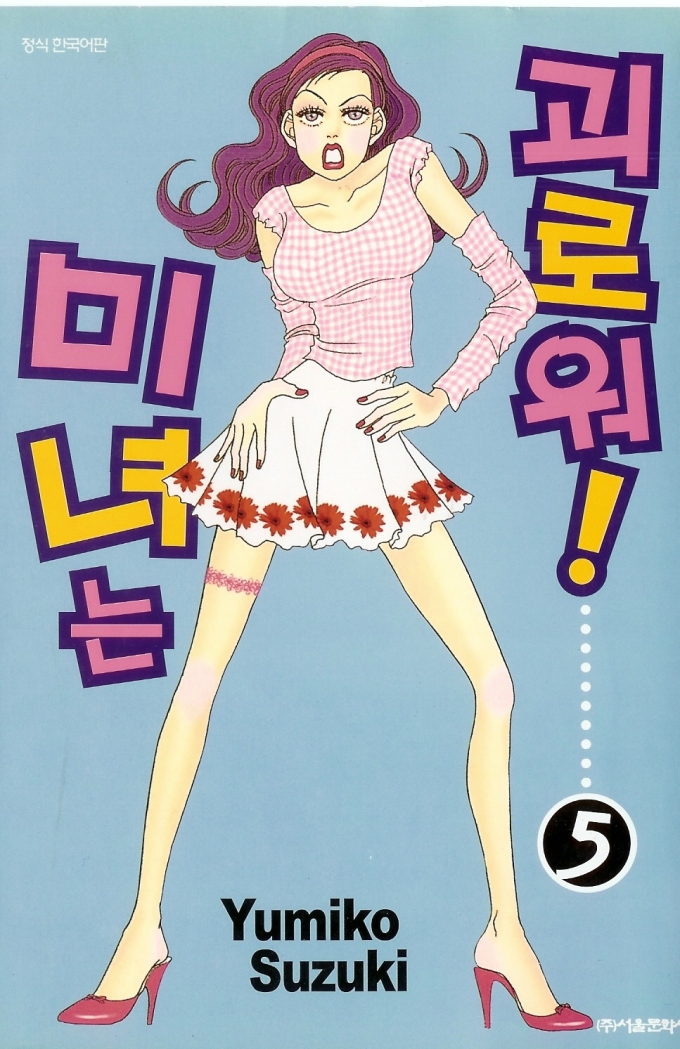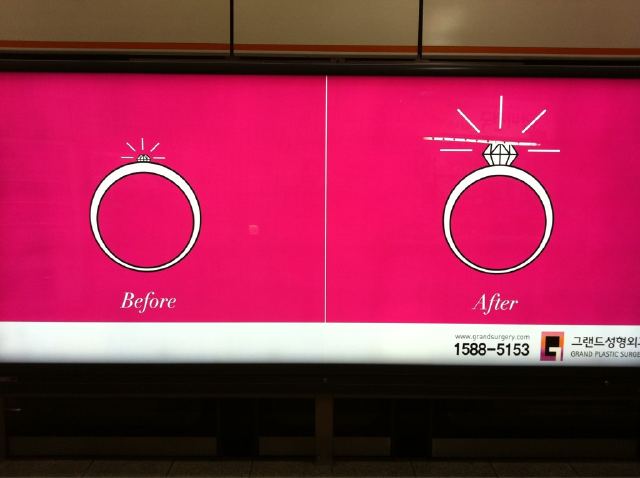 (Source)
(Source)
Do you think Arirang should have removed its Twist in Figures video from YouTube?
Shocked and outraged at something that castigated healthy, attractive women for not having legs like, well, the manhwa figure above, then my initial reaction was not just to insist on it, but feel that the original film reel should preferably be burned and the ashes buried too. However, reading the reaction from the Korea Studies community at the Korea Studies Discussion List later, now I think that in fact it may have been more useful for it to remain up.
Here’s some selected comments from the discussion thread, which, at the very least, demonstrate that the issues raised by the video are far more complex than they may seem at first glance. First, from Stephen Epstein, who first drew people’s attention to it:
I don’t usually send out links to the list, but the below piece from Arirang is one of the most absolutely reprehensible items of journalism that I ever seen and deserves wide circulation, as it offers an opportunity to combat the attitudes it reflects. The piece takes examples of female pop stars in Korea with “healthy” legs (yes, “healthy” is their word) but tries to suggest that “healthy” (i.e. anything but very nalsshinhada) is, in fact, bad. The promotion of extremely unhealthy body images and eating disorders is the logical outcome here.
The piece is getting hammered on YouTube (it’s only been up a day so far and running 15 to 1 dislike to like, maybe more, a ratio I’ve never seen, and the comments have all been appropriately scathing.). In any case, for those of you who ever have to teach anything about body image or plastic surgery in Korea, this will be eye-opening for students; you may want to download it as I suspect it will be taken down soon. Hopefully this piece will get wide attention (my own aim in sending this out) and Arirang will be forced into issuing a high-profile apology.
 (Source)
(Source)
A surprising and disappointing reaction later from Don Kirk:
Thank you for posting this piece back on you-tube. It’s quite an amusing commentary, actually, on Korean fashion, “girl groups,” models and society. There’s no reason to carry on a crusade about it. Arirang has a right to run such a feature. It seems extremely odd that academics, the first to defend freedom of speech and democratic rights, should attempt, in the name of political correctness, to want to suppress a simple feature piece that has colorful, fun, appealing images, pleasant and interesting commentary and actually something to say about current fashions and thinking.
There are views other than those of like-minded academics, who are not necessarily correct in all their political correctness. Shame on you, in the name of PC, for this disgraceful effort at suppression of free speech, free idea and free reporting.
A reply from Stephen:
I am willing to accept that suppressing the video is perhaps not the right tactic, and may infringe on expression of free speech. In fact, in retrospect, it probably would be better for the original to be up on the Arirang channel to allow it to take the scathing criticism it deserves and to encourage debate and draw attention to a serious problem in Korean society. I hardly wish to be part of a PC censorship brigade.
I also accept that the piece says something about current fashion and thinking. But it clearly crosses the line into promoting and not just reflecting that thinking. If you or anyone else really believes that this is a ” simple feature piece that has colorful, fun, appealing images, pleasant and interesting commentary”, without real world consequences, then I merely ask that you read some of the comments from YouTube users, hardly “politically correct academics”, on the original post from Arirang (I made sure to save them before the video might be taken down) and reconsider (source, below):
• Since when was being “healthy” a flaw? Healthy legs are not a good thing to have? tons of women would kill to have the women on that list’s legs!! This is disgusting: the girls you mentioned have fantastic figures. Note also that Suzy and Sulli are not even 18 yet! :|
• Again, I am highly disappointed in the way Arirang is encouraging UNHEALTHY body images. These girls have nice legs, with well-developed muscles. Why is that so wrong? Are girls supposed to project a helpless, useless image so that men will like them, is that it?
Shame on you, Arirang, for all of these stories. Help promote healthy, positive images for women in Korea and the rest of the world and stop telling them that “healthy” or “sturdy” or “muscular” is a bad thing.
• This is dumb. You’re promoting a ridiculous body image that will only make millions of girls insecure. These female celebs are perfect as they are. They don’t need a stick thin legs to support their upper bodies. As a broadcast station that goes international to promote South Korea and its culture, this only shows how ridiculous the standard of beauty and body image in Korea. Please re-evaluate the content of your programs and scripts before airing it. Avoid offensive contents like this.
• This is an awful message. Arirang you are promoting body shaming and purporting that healthy body images (actually all of the ladies in this video are probably TOO skinny) are wrong or unfashionable.
As someone who has had to deal with body issues and faced extreme pain over it, I hope you know that this video harms those in it and those watching it. Suzy is only turning 17 this year. As a teenage girl, Arirang, you have disgusted me with your lack of respect to the celebrities and ignorance.
• Do you realize how disgusting and twisted and WRONG it is for you to describe what you call imperfections in their lower bodies as “healthy.” If they are healthy, that means that don’t need to improve because they’re already perfect the way they are! The fact that you describe their supposedly imperfect legs as “healthy” implies that if they were to make the improvements you suggest, they would then become unhealthy. It’s this logic that pushes already beautiful women into eating disorders.
 (Source: @ornamentity)
(Source: @ornamentity)
Later, another point from Lauren Deutsch:
Thanks, guys, for taking the conversation public. Is it being debated likewise in Korea? Therein lies the clue to why the video and its free-wheeling commodification of women’s bodies are considered enough of a norm to be created and aired at all. It’s easier to study the culture (and others like it) from afar, but to willfully live in country gives this feminist pause for concern about a quality of life.
Then from Michelle Cho:
I agree that it’s important to think about the cultural norms that this video reflects, rather than isolating Arirang as the source of the problem (though I agree that the media should be held responsible for their integral role in circulating these sorts of images and “reports”). Many of the commenters on the Arirang youtube channel reserved their ire for Arirang and its tone-deafness, without mentioning the public’s appetite for the manufacture of celebrity bodies whose “perfection” is precisely not “healthy” because, in many ways, it’s not supposed to be human.
And this seems a good point to mention that, in fact, Arirang gave a very good report on excessively high rates of cosmetic surgery in Korea back in April 2010, as I wrote about (but forgot) here. Stressing how some women wanted cosmetic surgery for a slimmer figure, despite already being slimmer than average, it’s both a pity and genuinely strange that Arirang would post a report with such a radically different message less than a year later:
Continuing with Michelle Cho’s comment:
As a bilingual researcher, I found [the original video] especially illuminating for the sense of estrangement it elicited in me, precisely because the report was delivered *in English*. This makes me wonder whether Arirang international simply translated and rerecorded the narration for an entertainment story that ran in Korean. (I don’t know much about the English language Arirang channel and whether it produces its own content). Stories like this are not uncommon on Korean language television; it’s likely that “healthy” was a poor translation (I can think of a couple words that can connote both “stocky” and “healthy” in Korean). But the main point I’m trying to make here is that the politics of language are certainly at play here and shouldn’t be minimized.
Finally, another aspect of the report that I found quite interesting had to do with the latent discourse of proportionality and phenotype, which came through in one of the “expert commentators” analysis of one of the celebrities’ decision to wear ankle boots with a mini-dress. The commentator explains that it is difficult for East Asian women to pull off this fashion, because of their proportions, so the stakes of the standardization of correct proportions could also be read as an expression of anxiety regarding Western beauty ideals, at the same time that it signifies a desire to erase “East Asian” characteristics. (I hope I won’t be misunderstood here–I’m not suggesting that any of these putatively ethnic characteristics be given any legitimacy, I’m just pointing out the way the discourse seems to be operating).
Echoing Lauren, my thanks for bringing this discussion to the list. I believe it’s far more complex than it may seem at first glance, and I hope we can take this beyond criticisms of Arirang (though I think that was a good place to start.)
 (Source: @ornamentity)
(Source: @ornamentity)
From Henny Savenij:
I posted the video on Facebook and the Koreans liked it while the foreigners abhorred it, I guess that says enough.
Finally, from Tommy Vorst:
Obviously, the piece is offensive to many. But that’s not a crime. And it’s certainly not out of step with the entire fashion-celebrity industry, in any country. I can’t think of one that *doesn’t* consistently send out misogynist, unhealthy messages. The idea that any of these women were “in need of improvement” is ludicrous, of course. But they have chosen a profession in which such scrutiny is understood, expected and even appreciated. As a feminist, I cannot suggest that they are unwilling victims of such media criticism: they play the game voluntarily.
Arirang is no different from any other media outlet in its reporting: one need only look at any supermarket magazine rack or entertainment reporting programme to see that. What is surprising is the (IMO disingenuous) shock some are expressing. There is nothing shocking about such reports. Arirang may be the self-appointed face of Korea outside Korea (though I dispute this), but looking at popular Hollywood websites suggests Arirang is more in-step with their western counterparts than it is likely to be ‘an embarrassment:’
http://teens.aol.com/style/celebrity-body-parts
This discussion is a valuable one. One of our duties as academics is to shine the light on the cockroaches. But let’s not pretend this is anything out of the ordinary: this is an example of endemic sexism, not a shocking outlier. It’s appalling because of its normalcy.
 (Source)
(Source)
What do you think? Was it indeed disingenuous to be shocked by the report, as Vorst suggests? Or is the video extreme as Epstein argues, clearly crossing the line into promoting and not just reflecting on current fashion thinking?
Meanwhile, in the event that YouTube does remove the video again (with thanks to Roald Maliangkay for reuploading it), please note that it can be downloaded here.
Filed under: Body Image, Cosmetic Surgery, Dieting, Exercise, Gender Socialization, Korean Media Tagged: Arirang, calf, Calf Reduction Surgery, Calves, 성형수술




Recent comments